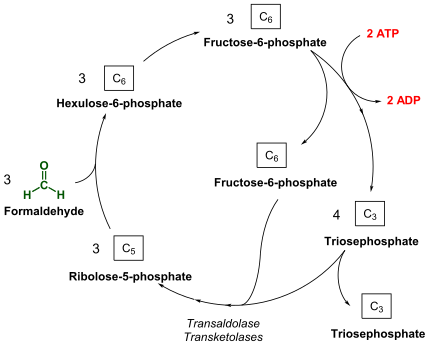Methanotroph
Methanotrophs (sometimes called methanophiles) are prokaryotes that metabolize methane as their only source of carbon and energy. They can grow aerobically or anaerobically and require single-carbon compounds to survive. These Methanotrophs are currently being modified to absorb methane from the atmosphere, because methane released into the atmosphere contributes to greenhouse gasses, which heat up the earth and cause global warming.
General
Under aerobic conditions, they combine oxygen and methane to form formaldehyde, which is then incorporated into organic compounds via the serine pathway or the ribulose monophosphate (RuMP) pathway. Type I methanotrophs are part of the Gammaproteobacteria and they use the RuMP pathway to assimilate carbon. Type II methanotrophs are part of the Alphaproteobacteria and utilize the Serine pathway of carbon assimilation. They also characteristically have a system of internal membranes within which methane oxidation occurs. Methanotrophs occur mostly in soils, and are especially common near environments where methane is produced. Their habitats include oceans, mud, marshes, underground environments, soils, rice paddies, and landfills. They are of special interest to researchers studying global warming, as they are significant in the global methane budget.[1][2]
Groups
Differences in the method of formaldehyde fixation and membrane structure divide the methanotrophs into several groups. These include the Methylococcaceae and Methylocystaceae. Although both are included among the Proteobacteria, they are members of different subclasses. Other methanotroph species are found in the Verrucomicrobiae.
Methanotrophy is a special case of methylotrophy, using single-carbon compounds that are more reduced than carbon dioxide. Some methylotrophs, however, can also make use of multi-carbon compounds which differentiates them from methanotrophs that are usually fastidious methane and methanol oxidizers. The only facultative methanotroph isolated to date are members of the genus Methylocella and Methylocystis.
In functional terms, methanotrophs are referred to as methane-oxidizing bacteria, however, methane-oxidizing bacteria encompass other organisms that are not regarded as sole methanotrophs. For this reason methane-oxidizing bacteria have been separated into four subgroups: two methane-assimilating bacteria (MAB) groups, the methanotrophs, and two autotrophic ammonia-oxidizing bacteria (AAOB).[2]
Properties
Gratuitous detoxification of some environmental contaminants such as chlorinated hydrocarbons by methanotrophs have made them attractive models for such bioremediation processes. Equally methane is a potential greenhouse gas far more potent than carbon dioxide. Therefore, methanotrophs play a major role in the reduction of the release of methane into the atmosphere from environments such as rice paddies, landfills, bogs, and swamps where methane production is relatively high.
Methanotrophs oxidize methane by first initiating reduction of an oxygen atom to H2O2 and transformation of methane to CH3OH using methane monooxygenases (MMOs).[3] Furthermore, two types of MMO have been isolated from methanotrophs: soluble methane monooxygenase (sMMO) and particulate methane monooxygenase (pMMO). Cells containing pMMO have demonstrated higher growth capabilities and higher affinity for methane than sMMO containing cells.[3] It is suspected that copper ions may play a key role in both pMMO regulation and the enzyme catalysis, thus limiting pMMO cells to more copper-rich environments than sMMO producing cells.[4]
Investigations in marine environments revealed that methane can be oxidized anaerobically by consortia of methane oxidizing archaea and sulfate-reducing bacteria. Anaerobic oxidation of methane (AOM) mainly occurs in anoxic marine sediments. The exact mechanism of methane oxidation under anaerobic conditions is still a topic of debate but the most widely accepted theory is that the archaea use the reversed methanogenesis pathway to produce carbon dioxide and another, unknown substance. This unknown intermediate is then used by the sulfate-reducing bacteria to gain energy from the reduction of sulfate to hydrogen sulfide. The anaerobic methanotrophs are not related to the known aerobic methanotrophs; the closest cultured relative to the anaerobic methanotrophs are the methanogens in the order Methanosarcinales.
Recently, a new bacterium Candidatus Methylomirabilis oxyfera was identified that can couple the anaerobic oxidation of methane to nitrite reduction without the need for a syntrophic partner.[5] Based on the studies of Ettwig et al.,[5] it is believed that M. oxyfera oxidizes methane anaerobically by utilizing the oxygen produced internally from the dismutation of nitric oxide into nitrogen and oxygen gas.
References
- ↑ Oremland, R. S.; Culbertson, C. W. (1992). "Importance of methane-oxidizing bacteria in the methane budget as revealed by the use of a specific inhibitor". Nature. 356 (6368): 421–423. Bibcode:1992Natur.356..421O. doi:10.1038/356421a0.
- 1 2 Holmes, AJ; Roslev, P; McDonald, IR; Iversen, N; Henriksen, K; Murrell, JC (1999). "Characterization of methanotrophic bacterial populations in soils showing atmospheric methane uptake". Applied and Environmental Microbiology. 65 (8): 3312–8. PMC 91497
 . PMID 10427012.
. PMID 10427012. - 1 2 Hanson, R. S.; Hanson, T. E. (1996). "Methanotrophic bacteria". Microbiological reviews. 60 (2): 439–471. PMC 239451
 . PMID 8801441.
. PMID 8801441. - ↑ Lieberman, R. L.; Rosenzweig, A. C. (2004). "Biological Methane Oxidation: Regulation, Biochemistry, and Active Site Structure of Particulate Methane Monooxygenase". Critical Reviews in Biochemistry and Molecular Biology. 39 (3): 147–164. doi:10.1080/10409230490475507. PMID 15596549.
- 1 2 Ettwig, K. F.; Butler, M. K.; Le Paslier, D.; Pelletier, E.; Mangenot, S.; Kuypers, M. M. M.; Schreiber, F.; Dutilh, B. E.; Zedelius, J.; De Beer, D.; Gloerich, J.; Wessels, H. J. C. T.; Van Alen, T.; Luesken, F.; Wu, M. L.; Van De Pas-Schoonen, K. T.; Op Den Camp, H. J. M.; Janssen-Megens, E. M.; Francoijs, K. J.; Stunnenberg, H.; Weissenbach, J.; Jetten, M. S. M.; Strous, M. (2010). "Nitrite-driven anaerobic methane oxidation by oxygenic bacteria". Nature. 464 (7288): 543–548. doi:10.1038/nature08883. PMID 20336137.
External links
- Anaerobic oxidation of methane
- Methane-Eating Bug Holds Promise For Cutting Greenhouse Gas. Media Release, GNS Science, New Zealand

